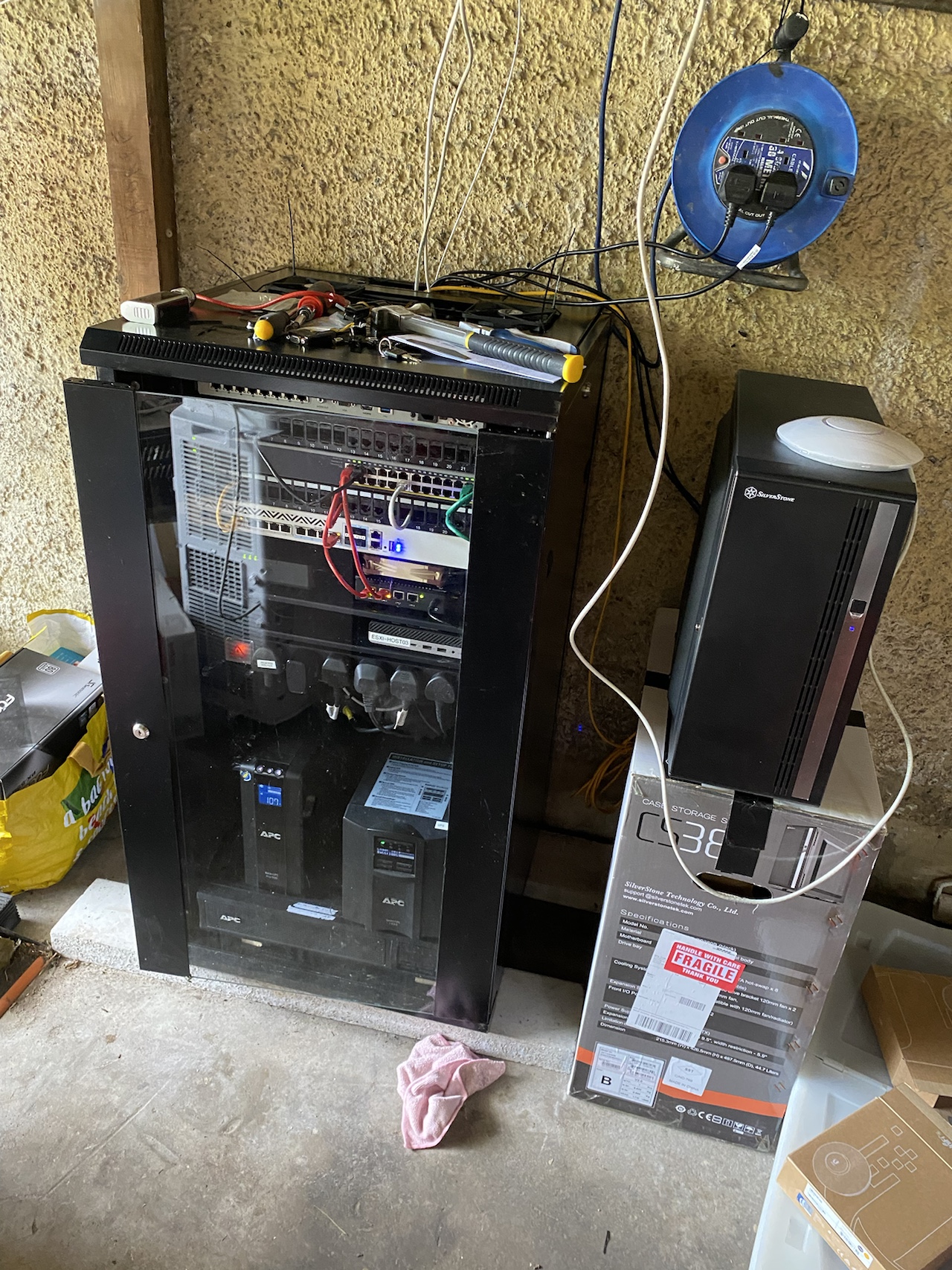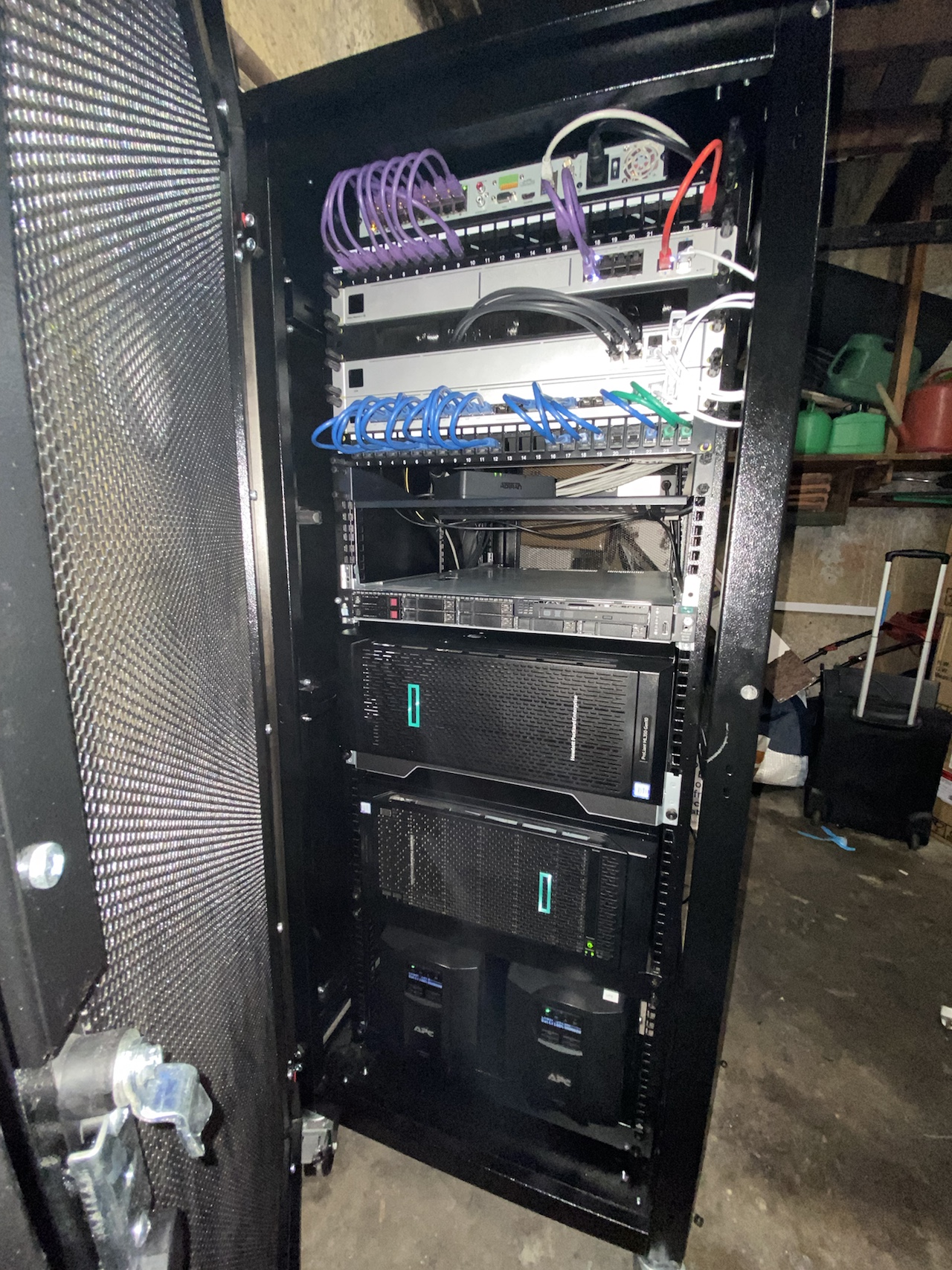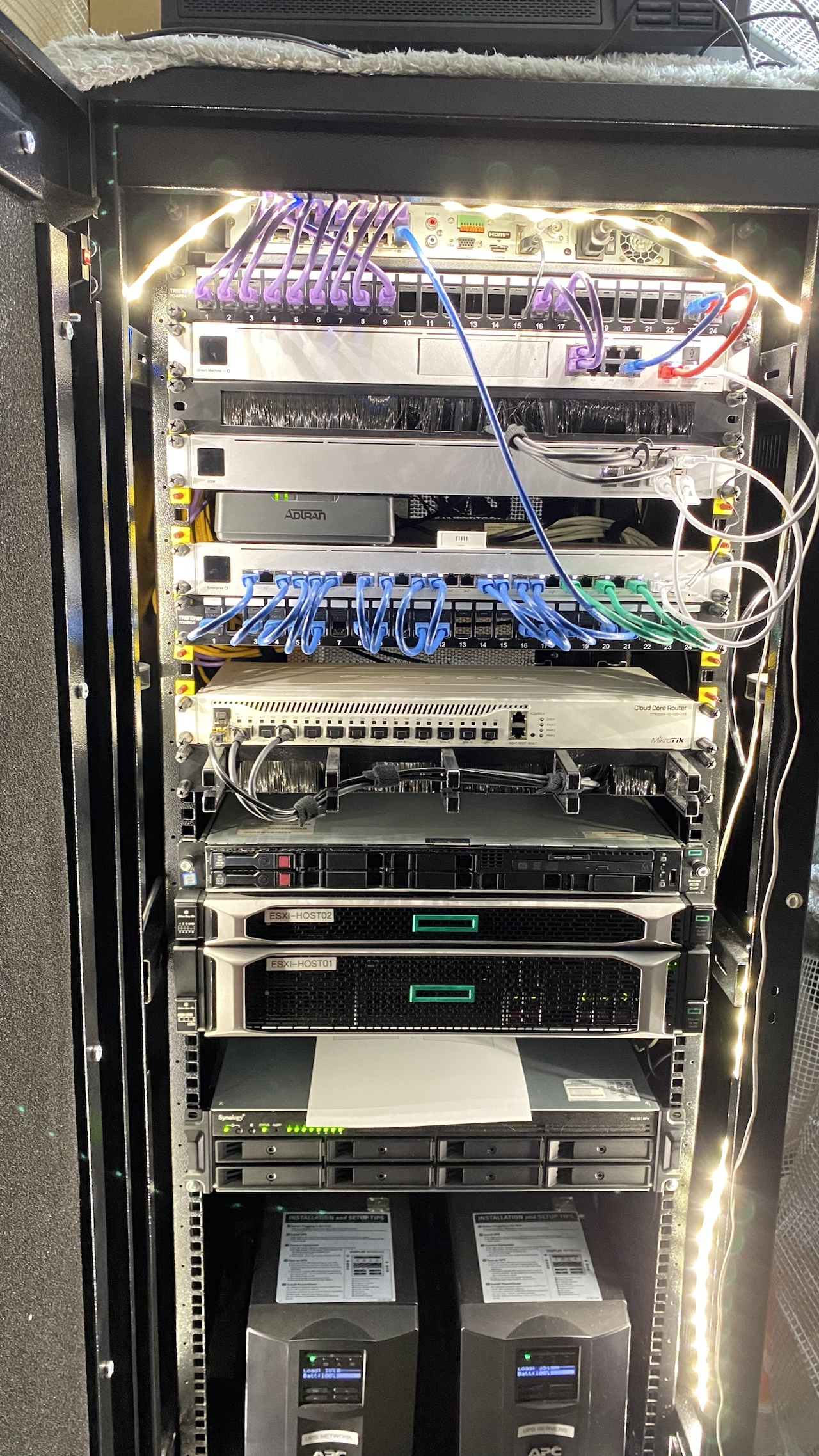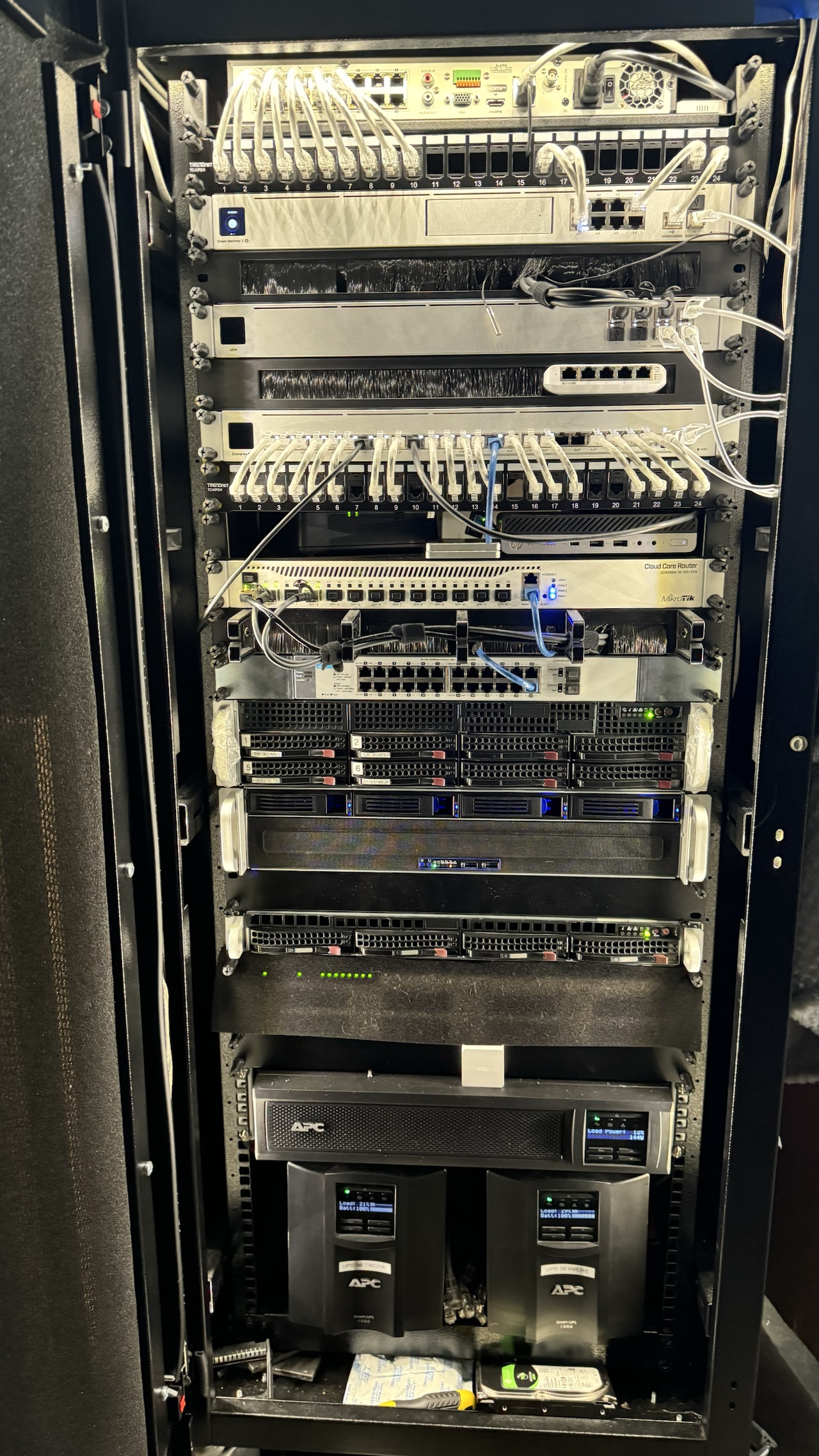Evolution of my homelab
Table of Contents
Introduction
In this post, I’ll walk you through how my homelab has evolved over the past 21 months.
What I changed and why, and the current setup that I plan to stick with for a while.
Homelab v1
In May 2023, my partner and I moved into a new house, and my homelab moved with us. Back then, I had a 21U rack with a depth of 60cm, housing all my networking gear. There wasn’t much at the time - just a few devices:
- Router with PFSense
- Netgear GS728TP v2 (1 Gbps switch)
- Mikrotik CRS312-4C+8XG-RM (10 Gbps switch)
- HikVision NVR
- Two patch panels
- HP Elitedesk 800 G3 running ESXi
- Three APC UPSs (though only two were in use)
Next to the rack, sitting on a cardboard box, was my DIY NAS running TrueNAS Scale.
Homelab v2
Homelab v1 didn’t last long. By the end of June, I decided to replace my entire network with Unifi gear:
- UDM SE router
- Unifi Enterprise 24 POE (1/2.5 Gbps switch)
- Unifi Aggregation (10 Gbps switch)
At the same time, I repurposed my TrueNAS Scale server as a backup unit and replaced my primary NAS with an HPE ML110 Gen10. Yeah, I know - it was a bit overkill. But what can I say? I got it for cheap, and it came with a decent config:
- Intel Silver 4110
- 64GB DDR4 ECC RAM
- dual PSUs.
It initially had only four 3.5" drive bays, but I managed to find a second cage, adding four more bays. Of course, I continued using TrueNAS Scale.
For virtualization, I upgraded to an HPE ML350 Gen10 - another great bargain.
This beast had:
- dual Intel Silver 4110 CPUs
- 32GB DDR4 ECC RAM
- dual PSUs.
Back then, ESXi was still independent from Broadcom, and that’s what I ran on it.
Since my rack wasn’t designed for servers, both the ML110 and ML350 had to sit on a shelf next to it.
Unfortunately I don’t have a picture of the server shelves…
Homelab v3
Just two months later (August 2023), it was time for another upgrade!
At work, we relocated our servers to a new room, leaving an unused rack behind. A quick chat with my boss, and I got the green light to take it home. That’s how my homelab got an ORION 29U rack with a depth of 100cm. Finally, I could fit everything into one rack - huge win!
Along with the rack, I also added an HPE DL120 Gen9 to my setup. I didn’t use it much - mostly as a backup or testing server. For most of its life in my rack, it was powered off.
Around this time, I also started using Home Assistant, running it on a Dell laptop. It stayed there for quite a while.
Homelab v4
Fast forward two months (October 2023), and yet another big change happened.
I replaced my HPE ML350 Gen10 with two rack-mounted HPE servers: DL360 Gen10 and DL380 Gen10. They weren’t top-tier configs - both had Intel Bronze CPUs, 32GB DDR4 ECC RAM, P408i-a RAID controllers, and dual PSUs.
I immediately upgraded them with:
- Four Intel Silver 4116 CPUs
- 256GB RAM
- PCIe risers and dual-port 10 Gbps SFP+ NICs
- Front bezels (which made them look way better!)
A few days later, I swapped my HPE ML110 Gen10 for a Synology RS1221RP+. The ML110 was consuming too much power for a simple NAS. The RS1221RP+ turned out to be a great choice - I really liked Synology’s software. I set it up once, and it’s been running flawlessly ever since.
Small Hosting Project
At the beginning of 2024, I decided to start hosting game servers. To do that, I bought a GRE tunnel with multiple public IPs and a Mikrotik CCR2004-1G-12S+2XS router. It’s a solid piece of hardware that never let me down - unlike the tunnel provider, which was a constant source of headaches.
Homelab v5
The next big change came in August 2024.
Intel Silver CPUs weren’t great for game servers, so I moved away from HPE and built two custom servers with AMD Ryzen CPUs.
They were quite similar, with the main differences being the CPU and case.
First server:
- SuperMicro CSE-825 2U case with dual PSUs
- AMD Ryzen 5900X
- Gigabyte MC12-LE0 motherboard
- 4x 32GB DDR4 ECC RAM
- Dual-port 10 Gbps SFP+ NIC
Second server:
- IPC Storage 2U-2404L case
- AMD Ryzen 5700X
- Gigabyte MC12-LE0 motherboard
- 4x 32GB DDR4 ECC RAM
- Dual-port 10 Gbps SFP+ NIC
- NZXT 550W PSU
Both servers performed great, and I had zero issues with them.
In addition to the two servers I built, I also added a SuperMicro CSE-815 server with the following specifications:
- Intel Xeon CPU E5-2650L v4 processor
- 64GB DDR4 ECC RAM
- SuperMicro X10SRi-F motherboard
- two redundant power supplies
Closing Hosting
Due to constant issues with the tunnel provider and poor customer support, I lost almost all my clients. By December 2024, I decided to shut down my hosting business. Running everything solo while working full-time was too much. Looking back, I think it was the right call.
Once I shut down the hosting, I no longer needed those high-performance servers, which led to…
Homelab v6
At the start of this year, I built yet another version of my homelab.
This time, I went for non-enterprise hardware, and honestly, I’m really happy with it.
So, my friends, meet my new setup: HP Elitedesk 800 G4 mini PCs! Small, efficient, and perfect for my needs. Specs of my main nodes:
- Intel i5-8500 (6C/6T)
- 32GB DDR4 RAM
- 256GB SSD for Proxmox
- 1TB Kingston KC3000 NVMe for Ceph storage
- 1 Gbps onboard NIC
- 2.5 Gbps NIC for Ceph (M.2 or USB adapters)
Right now, my cluster consists of three Elitedesk 800 G4s and one older Elitedesk 800 G3. The G3 is slightly outdated but still useful. Specs of the G3:
- Intel i5-6500 (4C/4T)
- 32GB DDR4 RAM
- 256GB SSD for Proxmox
- 1TB Crucial P5 Plus NVMe for Ceph storage
- 1 Gbps onboard NIC
- 2.5 Gbps NIC for Ceph (USB adapter)
A huge plus of these mini PCs is the dual M.2 slots for NVMe drives, a SATA port, an M.2 A+E slot for a 2.5 Gbps NIC, and Intel AMT for remote management.
I also moved everything from the 29U rack into a smaller 21U rack and relocated it to a utility room. My garage wasn’t insulated, which meant running a heater in winter and AC in summer - too expensive. Moving the lab was a smart choice.
Conclusion
Over the past 21 months, my homelab has changed quite a bit. My current setup should last longer than previous ones, but we all know how that goes. Who knows? Maybe in a few months, I’ll be making changes again.
That’s all for now! I was going to share my plans for the next few months, but I’ll save that for a separate post.
Thanks for reading - especially if you made it to the end! See you in the next post!
Cheers,
Lukas
comments powered by Disqus







